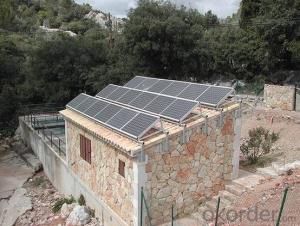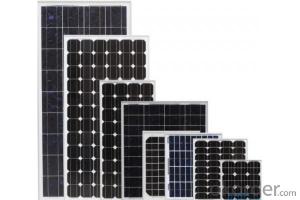25w Small Solar Panels with Good Quality for Solar Energy Systems in California
- Loading Port:
- China main port
- Payment Terms:
- TT OR LC
- Min Order Qty:
- 1 watt
- Supply Capability:
- 10000000 watt/month
OKorder Service Pledge
OKorder Financial Service
You Might Also Like
Specification
Product Description:
Hot Sale !!! Quality and Safety of Small Poly Solar Panel 35~85w
1. Rigorous quality control meets the highest international standards.
2. High-transmissivity low-iron tempered glass, strong aluminium frame.
3. Using UV-resistant silicon.
4. IS09001/14001/CE/TUV/UL
Warranties of Small Poly Solar Panel 35~85w
1. 10 years limited product warranty
2. 15 years at 90% of the minimal rated power output
3. 25 years at 80% of the minimal rated power output
Specification
Characteristics of Poly solar panels CNBM (245-320W) | |||||
Max Power Voltage Vmp(V) | 30.3 | 30.8 | 31.1 | 31.4 | 31.85 |
Max Power Current Imp(A) | 7.60 | 7.64 | 7.73 | 7.81 | 7.85 |
Open Circuit Voltage Voc(V) | 36.1 | 36.6 | 37 | 37.3 | 37.68 |
Short Circuit Current Isc(A) | 8.50 | 8.55 | 8.65 | 8.75 | 8.85 |
Max Power Pm(W) | 230W | 235W | 240W | 245W | 250W |
Temperature Coefficient of Cells Poly solar panels CNBM (245-320W) | |
NOCT | 45± 2 |
Temperature Coeffucients of Isc | 0.0492 |
Temperature Coeffucients of Voc | -0.3374 |
Temperature Coeffucients of Voc | -0.4677 |
Mechanical Data of Poly solar panels CNBM (245-320W) | |
Dimension | 1638 × 982 × 40 mm |
Weight | 19.5 kg |
No. of Cells and Connections | 60 (6 ×10) |
Tolerance | 0 ~ + 5 W |
Cell | Monocrystalline Cell 156 × 156 mm |
Packing | 624 Pcs/40ft(H) Container |
Limits of Poly solar panels CNBM (245-320W) | |
Operating Temperature | -40 to +85 |
Storage Temperature | -40 to +85 |
Max System Voltage | 1000VDC(IEC) / 600VDC(UL) |
Features of our products:
• High conversion efficiency mono/poly-crystalline amorphous silicon solar cells
• Modules incorporate high performance bypass diodes to minimize the power drop caused by shading
• High transmittance, low-iron tempered glass
• High performance EVA encapsulant to prevent destroying and water.
• AI frame: without screw, corner connection. 8 holes on the frame can be installed easily
• Good performance of preventing from atrocious weather such as wind and hails
• Certifications: CE IEC TUV VDE UL, Class I
• 10 years 90% power output warranty

Shipping of Small Poly Solar Panel 35~85w
By Sea | Delivery from Shanghai or Ningbo seaport |
By Air | Departure from Shanghai Pudong Airport |
By Express | Post by DHL, EMS, UPS, TNT. |
- Q: Can solar energy systems be used for powering residential or commercial air conditioning systems?
- Yes, solar energy systems can be used for powering residential or commercial air conditioning systems. Solar energy can be harnessed through the use of solar panels or solar thermal systems, and this energy can be converted into electricity to power air conditioning units. Solar panels work by capturing sunlight and converting it into direct current (DC) electricity, which can then be converted into alternating current (AC) electricity using an inverter. This AC electricity can be used to power various appliances, including air conditioning systems. Additionally, solar thermal systems can use the sun's heat to directly power air conditioning units by heating a fluid, such as water or refrigerant, which can then be used to cool the air. Solar energy systems for air conditioning can help reduce electricity bills and carbon emissions, making them a sustainable and cost-effective option for residential and commercial buildings.
- Q: Can solar energy systems be installed on the ground?
- Yes, solar energy systems can be installed on the ground. Ground-mounted solar systems are a common and effective way to harness solar energy. They are installed on open land or in open spaces and can be scaled to accommodate various energy needs. Ground-mounted systems offer flexibility in terms of orientation and tilt angles, ensuring optimal sun exposure for maximum energy production.
- Q: Can solar energy systems be used for powering water pumps in rural areas?
- Yes, solar energy systems can definitely be used for powering water pumps in rural areas. Solar-powered water pumping systems are increasingly being used in remote areas where access to electricity is limited or expensive. These systems use solar panels to capture sunlight and convert it into electricity, which is then used to power the water pumps. This sustainable and renewable energy solution is cost-effective, environmentally friendly, and can provide a reliable source of water for agricultural, domestic, and irrigation purposes in rural communities.
- Q: How does the angle of incidence affect the performance of solar panels?
- The angle of incidence greatly affects the performance of solar panels. When the angle of incidence is optimal (usually perpendicular to the sun's rays), solar panels can generate maximum power output. However, as the angle deviates from the optimal position, the power output decreases. Therefore, it is crucial to adjust the angle of solar panels to optimize their performance and maximize energy production.
- Q: What is the environmental impact of solar energy systems?
- Solar energy systems have a significantly positive environmental impact. They generate electricity without emitting greenhouse gases or harmful pollutants, reducing air pollution and combating climate change. Additionally, solar energy systems require minimal water usage compared to fossil fuel-based power plants, minimizing strain on water resources. This renewable energy source also helps conserve natural resources and reduces our reliance on finite fossil fuel reserves. Overall, solar energy systems contribute to a cleaner and more sustainable environment.
- Q: What is the role of solar energy systems in disaster resilience?
- Solar energy systems play a crucial role in disaster resilience by providing a reliable and sustainable source of power during emergencies. These systems can power essential infrastructure such as hospitals, emergency shelters, and communication networks when the main grid fails or is damaged. Additionally, solar energy systems are resilient to fuel shortages and can continue to generate electricity even when traditional energy sources are disrupted. This not only ensures the uninterrupted operation of critical services but also reduces dependence on fossil fuels, making communities more self-sufficient and environmentally friendly in times of crisis.
- Q: How does the presence of nearby power lines affect the performance of solar panels?
- Solar panels can be affected in both positive and negative ways by the presence of nearby power lines. On the positive side, power lines can serve as a reliable backup source of electricity when solar panels are unable to generate sufficient power due to cloudy or low-light conditions. This is particularly advantageous for properties that heavily rely on solar energy and cannot tolerate any interruptions in their power supply. Conversely, the close proximity of power lines can also have detrimental effects on solar panel performance. Shading is a major concern in this case, as power lines often cast shadows on the panels, resulting in reduced overall output. Even a slight amount of shading can significantly impair the efficiency of a solar panel, disrupting the flow of photons and diminishing the amount of sunlight that can be converted into usable electricity. Moreover, placing solar panels near power lines can lead to electromagnetic interference (EMI), which can disrupt their normal functioning and impede their ability to convert sunlight into electricity. This interference can cause a decline in energy production and efficiency. It is important to acknowledge that the specific impact of nearby power lines on solar panel performance can vary depending on several factors, including the distance between the power lines and the panels, the panels' angle and orientation, and the design and quality of the panels themselves. To address these potential issues, it is advisable to carefully plan and design the installation of solar panels, taking into account the proximity of power lines. This may involve adjusting the angle and orientation of the panels to minimize shading and situating them in areas with minimal electromagnetic interference. Additionally, regular maintenance and cleaning of the solar panels can help optimize their performance, irrespective of the presence of nearby power lines.
- Q: Can solar energy systems be used in areas with high levels of noise pollution?
- Yes, solar energy systems can be used in areas with high levels of noise pollution. Solar panels do not produce any noise themselves, as they generate electricity by converting sunlight into energy. Therefore, noise pollution does not affect the performance or functionality of solar energy systems.
- Q: How much space is needed for a solar energy system installation?
- The space required for a solar energy system installation depends on various factors such as the system size, type of solar panels used, and the available sunlight. On average, a 1 kW solar panel system requires around 100 square feet of space. Therefore, for larger systems, more space will be needed. Additionally, the orientation and tilt of the panels can also impact the space requirements. It is recommended to consult with a solar energy professional who can assess your specific needs and provide accurate information regarding the space needed for a solar energy system installation.
- Q: What is the efficiency of a solar energy system?
- The efficiency of a solar energy system refers to the percentage of sunlight that is converted into usable electricity. It is a measure of how effectively the system can harness and convert solar energy into electrical power. The efficiency of a solar energy system can vary depending on various factors such as the type of solar panels used, the location and orientation of the panels, weather conditions, and the overall design and quality of the system. Typically, the efficiency of commercially available solar panels ranges from 15% to 22%. This means that only a portion of the sunlight that reaches the panels is converted into electricity, while the rest is either reflected or lost as heat. However, advancements in solar technology are constantly being made, and there are experimental panels that have achieved efficiencies of over 40%. It is important to note that the efficiency of a solar energy system does not solely determine its overall effectiveness. Factors such as the cost, durability, and maintenance requirements of the system also play a significant role in determining its overall value. Additionally, the efficiency of a system can be maximized by optimizing its installation, regularly cleaning the panels, and ensuring that there are minimal obstructions to sunlight. In summary, the efficiency of a solar energy system is a measure of how well it converts sunlight into electricity. While the efficiency of commercially available solar panels typically ranges from 15% to 22%, advancements in technology continue to improve this figure. However, other factors such as cost, durability, and maintenance requirements should also be considered when evaluating the effectiveness of a solar energy system.
Send your message to us
25w Small Solar Panels with Good Quality for Solar Energy Systems in California
- Loading Port:
- China main port
- Payment Terms:
- TT OR LC
- Min Order Qty:
- 1 watt
- Supply Capability:
- 10000000 watt/month
OKorder Service Pledge
OKorder Financial Service
Similar products
Hot products
Hot Searches
Related keywords






























